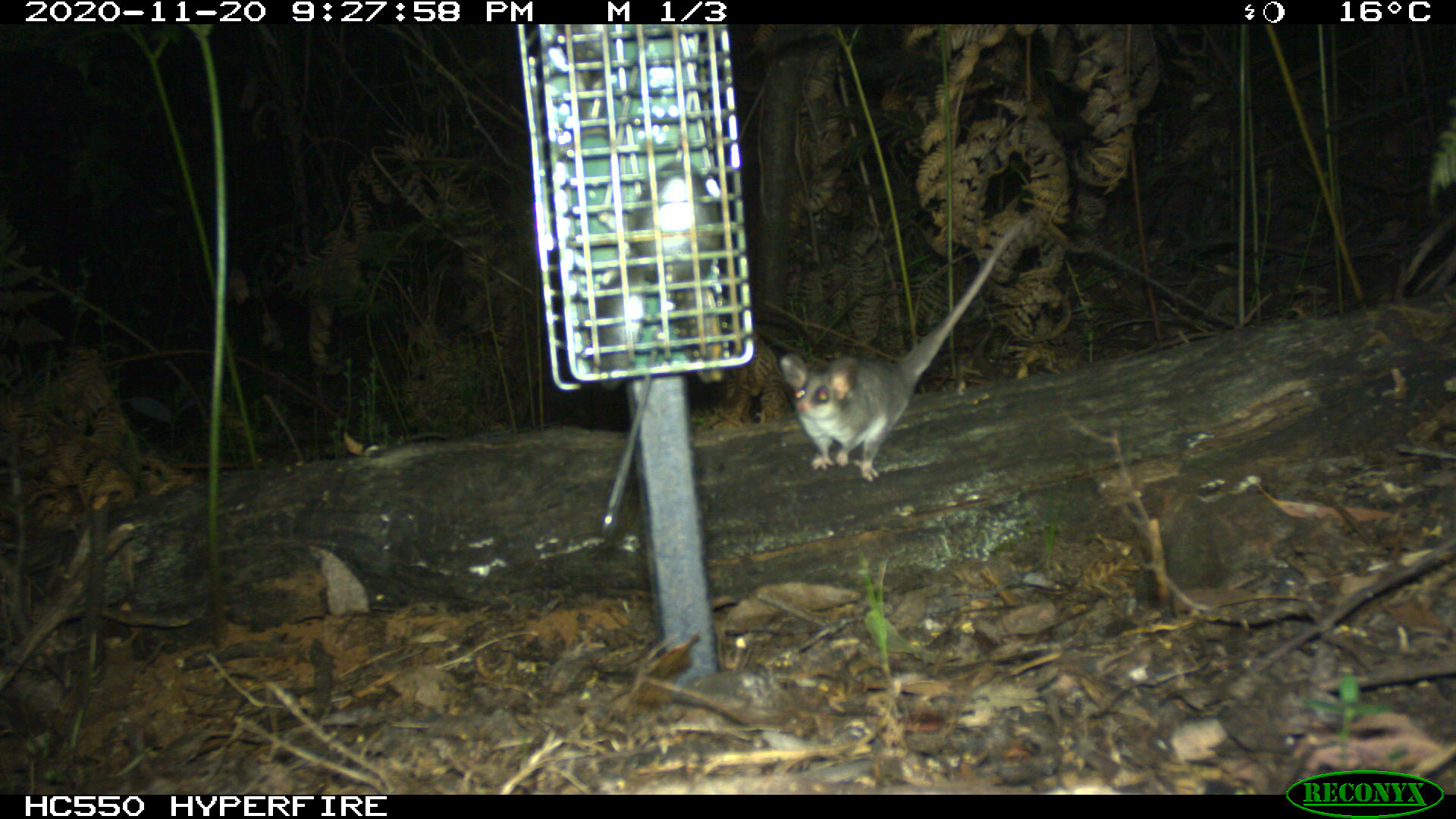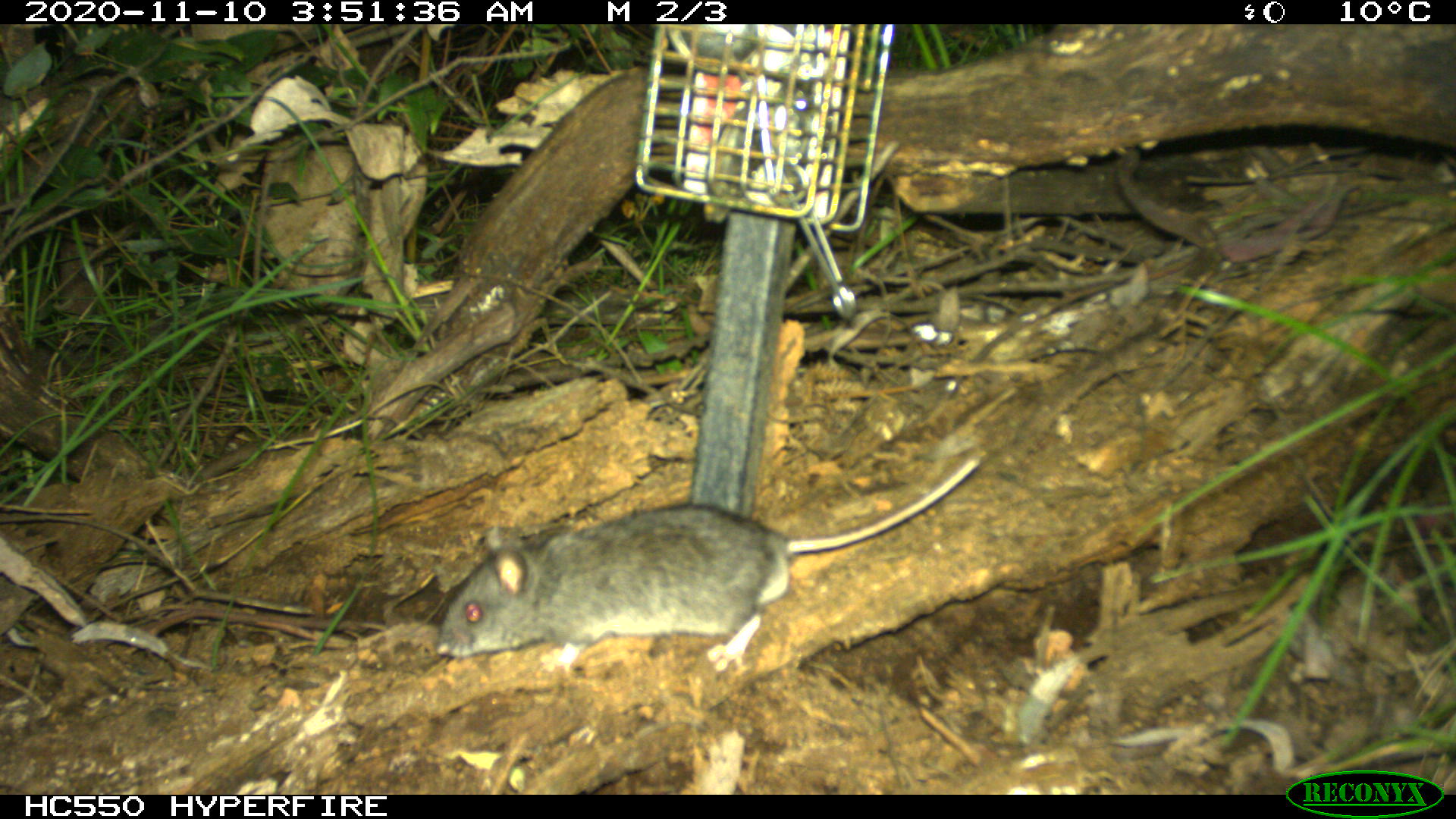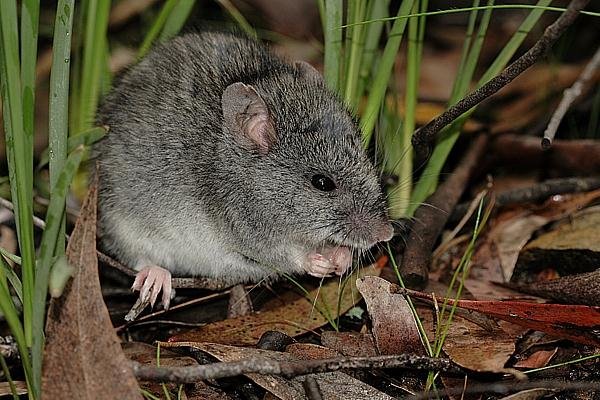The 2019-20 bushfires burned through approximately 25% of the habitat of the endangered Smoky Mouse. © Dr. Phoebe Burns
WildArk, Aussie Ark, and Global Wildlife Conservation awarded $15,977 from our Australian Endangered Species Recovery Fund to Native Mouse Ecological Consulting’s Dr. Phoebe Burns for her research project ‘Post-Fire Resilience of the Endangered Smoky Mouse (Pseudomys fumeus). The grant was awarded as part of the Koala Comeback Campaign which aims to support bushfire recovery and rehabilitation efforts for native flora and fauna in Australia.
The Smoky Mouse is an endangered rodent native to south-eastern Australia. The 2019-20 bushfires tore through approximately 25% of the species’ total habitat. While they shelter in underground burrow systems and can persist through fire itself, the post-fire landscape leaves Smoky Mice extremely vulnerable to predation and food shortages. A sharp blow after a devastating bushfire season.
In response, Native Mouse Ecological Consulting will conduct surveys of recently burned and adjacent unburned areas in the Victorian Alps to determine the status of the Smoky Mouse. This will then allow them to assess the need for targeted management intervention to aid the protection and recovery of this species.
We spoke to principal ecologist, Dr. Phoebe Burns about her work with native mammals in Australia and her Smoky Mouse research.


Eastern Pygmy Possum (left) and Smoky Mouse (right) captured by Dr. Burns’ camera traps. © Dr. Phoebe Burns
WildArk: Why did you decide to specialise in the conservation and fire ecology of mammals?
Dr. Burns: As a kid, I wanted to work in wildlife conservation but didn’t think it was an actual viable career option. I chose to study zoology at university anyway and see where it took me and was relieved to discover that many of my university lecturers had made careers out of wildlife research. There was a whole world of wildlife science and management that suddenly opened up to me and I’ve single-mindedly pursued that path ever since.
The fire ecology aspect of my work was more of an accident or rather a necessity. Back in 2013, I was about to start fieldwork for a research project on Smoky Mouse vegetation associations in the Grampians when all my sites burned in a high severity bushfire. Areas that had been lush, wet, tree-fern-filled gullies were reduced to ashen grey moonscapes and leafless, blackened trees. Unable to investigate what plants the mice preferred – as there were no plants left – I shifted my study to look at how the mice responded to fire in the immediate aftermath and in the years of regeneration that followed. Because fire plays such a huge role in the Australian landscape, both as bushfires and as a management tool, understanding it has become an integral part of conserving many of the species I work on.
WildArk: Throughout your eight years of ecological research experience, what have you identified as some of the biggest risks facing our threatened rodents, and have you seen any shifts in prevalent threats?
Dr. Burns: Even in the relatively short time I’ve been working as an ecologist, I’ve seen a dramatic escalation in the effects of climate change. From the increased intensity and frequency of extreme fire events to devastating periods of drought that have crashed populations of threatened species, climate change is already changing ecosystems. While we can make a difference by focusing on managing and conserving individual species and locations, we still need urgent action on climate change at a higher level to prevent ecosystem collapse at a scale that we can’t remedy.
WildArk: Can you tell us a bit about what is so special about the Smoky Mouse, and its current status?
Dr. Burns: The Smoky Mouse is a delightful little animal; docile and charming with impossibly soft blue-grey fur, a white belly, and a twitchy little pink nose. From an ecological perspective, the Smoky Mouse plays an important role in the dispersal of seeds and fungi and helps maintain and improve soil health through digging burrows and while foraging for food. Unfortunately, the species is Endangered due to threats such as predation by cats and foxes, drought, increasing fire frequency and severity, and habitat loss. We’ve lost them from some regions where they were once abundant, and we’re noticing declines in remnant populations.

Dr Phoebe Burns setting up camera traps in the Victorian Alps. © Dr. Phoebe Burns
WildArk: You were awarded one of the Australian Endangered Species Recovery Fund grants for your ‘Post Fire Resilience of the Smoky Mouse’ project. What sort of information do you wish to gather about the Smoky Mouse?
Dr. Burns: The 2019-20 bushfires burned through approximately 25% of the habitat of the endangered Smoky Mouse. A key impediment to conservation planning for the species is uncertainty regarding its current status across much of its range. In particular, most of the species’ range in the Victorian Alps has not been surveyed since the 1970s, despite every historical site having burned in one or more bushfires since 2000. Through funding from the Australia Endangered Species Recovery Fund, I’m investigating the species’ response to the 2019-20 bushfires across the Victorian Alps to determine the status of the Smoky Mouse, assess its response to recent fires and inform management priorities and interventions.
WildArk: What are some of the ways in which you aim to survey the Smoky Mouse?
Dr Burns: I use camera traps to find populations of Smoky Mice; camera traps are basically cameras with motion and heat sensors, so if a mouse walks past it will trigger the camera to take a photo of it. To improve the chances of Smoky Mice happening to walk past my cameras, I bait them with a delicious-smelling mix of peanut butter, oats, golden syrup and vanilla extract. Once populations are located, I can go back in with live traps to catch the animals in hand, get a measure of population size and take genetic samples so we can understand the species’ connectivity across its range and whether they’re genetically healthy.
WildArk: Over what sort of area do you wish to survey within the Victorian Alpine National Park and surrounding areas?
Dr Burns: My survey efforts are focused on areas of the Victorian Alpine National Park and Tea Tree Range State Forest where Smoky Mice were historically detected, and that were impacted by the 2019-20 bushfires. I’m targeting areas that burned in the fires as well as adjacent unburned areas to see how the species is responding to the fire and to reassess its status in the area for the first time in decades.
WildArk: As the Smoky mouse burrows underground during bushfires, what makes it so vulnerable in a post-fire landscape?
Dr Burns: While the Smoky Mouse will usually be safe underground in a burrow during a fire itself, the post-fire landscape can be harsh and population numbers tend to decline sharply after the fire. Smoky Mice are a lot slower and more naïve than many other rat and mouse species you may think of, which makes them highly susceptible to being eaten by predators. With all the ground-level vegetation burnt away and nothing to hide behind, predation in the post-fire landscape can be a lot more intense. They tend to persist better in areas with ground-level complexity that didn’t burn much and rocks and logs.


Severe fires such as the bushfires of 2019 – 2020 can make a habitat completely unsuitable for species such as the Smoky mouse. © Dr. Phoebe Burns
WildArk: What are some of the effects of extreme bushfire events on the biodiversity of these areas, in particular the effect on the Smoky Mouse?
Dr. Burns: When a really high severity bushfire burns through a large area as happened in 2019-20, it can make the area completely unsuitable for a species for months or even years. For a species to move back into that area once it becomes suitable habitat again, there need to be populations nearby in unburnt patches or patches that burned less severely. For rare species, populations are often small and isolated, so large disturbance events can wipe out an entire population and without any nearby animals to recolonise, you may lose that species from the area forever.
I detected Smoky Mice at three of the 83 sites I surveyed in the Alps; two of these were in unburned habitat on the edge of the fire scar, and one was about 2km inside the fire scar at a severely burned site. While numbers have likely dropped in the burned areas, the species is still holding on so things are looking positive for now. I’ll be heading back out there soon to get an idea of population numbers and the genetic health of the remaining mice.
WildArk: How will the information you gather from these critical surveys help aid to establish effective management strategies?
Dr. Burns: The information gathered in these surveys gives us a better picture of the status of Smoky Mice in Victoria, their distribution and their response to the recent fires. Knowing where the mice persist and why allows us to focus our management efforts on the populations that need it most, and also to evaluate the success of existing management strategies, such as fox baiting. The more we know of how they respond, the better placed we will be to jump in and help them out in future bushfire events.
WildArk: What sort of strategies have you seen in the past to help better regulate the biodiversity of bushfire affect areas, that may be influential in protecting the Smoky Mouse?
Dr. Burns: One of the key factors in the post-fire environment is predator control. Land managers have become really good at fox control, and we can see clear benefits of that in things like the high number of Long-Footed Potoroos across this study area. Cat control is a much tricker one to manage (they can be really hard to catch!), yet cats may be far worse for smaller animals such as Smoky Mice.
Other successes for small mammals in the post-fire landscape are things like the supplemental feeding program for Mountain Pygmy Possums – Bogong Bikkies. Depending on how things go with Smoky Mice, we might consider developing a similar option for responses to extreme drought or fire situations.

The Smoky Mouse plays an important role in the dispersal of seeds and fungi and helps maintain and improve soil health through digging burrows and while foraging for food. © Research Gate
The Australian Endangered Species Recovery Grant is part of the Koala Comeback Campaign. It aims to provide funding for organisations carrying out research projects that quantify the bushfire’s impact on Australia’s threatened species and identify urgent needs that exist for wildlife living in fire-affected areas.
Ten exceptional projects, including this one, will be awarded grants of up to $16,000 for their outcomes-based research that has measurable outcomes in the next 12 months. Much of this research includes species population surveys, protecting unburnt habitat, or implementing other critical interventions identified by species experts.
Thanks to generous donations, the #KoalaComeback campaign, a partnership between WildArk, Global Wildlife Conservation, and David Yarrow Photography, has supported many organisations working on the frontlines bushfire recovery and habitat protection in the wake of the 201991-2020 bushfires.
–
Read more about the Australian Endangered Species Recovery Fund HERE.
